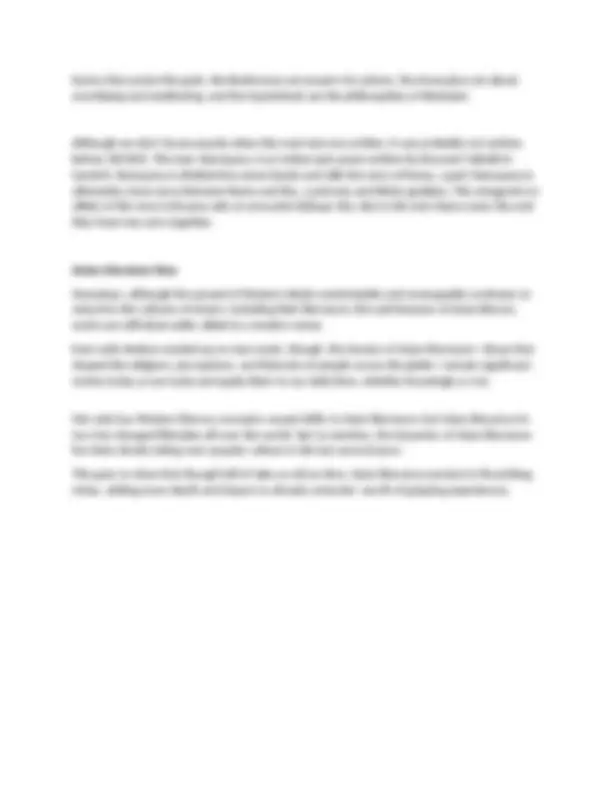



Study with the several resources on Docsity

Earn points by helping other students or get them with a premium plan


Prepare for your exams
Study with the several resources on Docsity

Earn points to download
Earn points by helping other students or get them with a premium plan
Community
Ask the community for help and clear up your study doubts
Discover the best universities in your country according to Docsity users
Free resources
Download our free guides on studying techniques, anxiety management strategies, and thesis advice from Docsity tutors
An overview of ancient Asian literature, with a focus on Indian literature. It discusses the religious and reflective nature of some of the oldest literary masterpieces in India, such as the Veda hymns and the epics of Ramayana and Mahabharata. It also covers the different stages of Indian literature, including Adikal, Bhakti Kal, Ritikal, and Adhunikaal literature. The document also touches on the political themes in Indian literature, such as calls for justice, feminism, and pacifism. The second part of the document provides a brief overview of ancient literature in Asia, with a focus on China and India.
Typology: Lecture notes
1 / 2

This page cannot be seen from the preview
Don't miss anything!


Indian Literature Yet another epitome of Asian literature is that of India, in which some of the oldest literary masterpieces are religious and reflective in nature, becoming the basis for the major religion of Hinduism. Examples include the Veda hymns and the epics of Ramayana and Mahabharata, all of which inspire morals and philosophy in the form of myths, chants, narratives, and verses. The rest of Indian literature molded itself over the years after these ancient texts. India’s renowned writer, Rabindranath Tagore, exemplified such styles in his romantic works that spanned spiritual and mystic themes mainly in various forms of prose and poetry. The Adikal stage of Indian literature was another example of spiritually-inclined poetic pieces, emphasized further by the next stage of Bhakti Kal literature, which personified God. Ritikal Literature centered on notions of love, while Adhunikaal literature has presented itself even until the modern era in the form of more varied texts; novels, short stories, and dramas of every genre has become apparent, especially written in the English language that the British occupation brought. Other prominent features of Indian literature and therefore, Asian literature are its political themes like topics surrounding calls for justice, as well as feminist and pacifist movements. Ancient Asian Literature Ancient history is usually defined as the time period up to 500 CE. That means that ancient literature would be literature that was written during this time period up to 500 CE. This lesson focuses on ancient literature written in Asia. Some of the most prominent countries in ancient Asia were China and India and so the literature of these two nations will be the focus of this lesson. Ancient literature is often closely related to religion and this is true of Ancient Asian literature as well. The ancient literature of India is primarily related to Hinduism while the ancient literature of China is mainly related to Daoism and Confucianism. Ancient Indian Literature Let's start with the ancient texts found in India. The Vedas are the oldest of Sanskrit literature and Hindu scripture. Sanskrit is the ancient language of India and Hinduism is an umbrella term describing many polytheistic religious traditions that originated in India. There are four parts to the Vedas: Samhitas, the Brahmanas, the Aranyakas, and the Upanishads. The Samhitas are
hymns that praise the gods, the Brahmanas are prayers for priests, the Aranyakas are about worshiping and meditating, and the Upanishads are the philosophies of Hinduism. Although we don't know exactly when this next text was written, it was probably not written before 300 BCE. This text, Ramayana, is an Indian epic poem written by the poet Valmiki in Sanskrit. Ramayana is divided into seven books and tells the story of Rama, a god. Ramayana is ultimately a love story between Rama and Sita, a princess and Hindu goddess. The antagonist or villain of the story is Ravana who at one point kidnaps Sita. But in the end, Rama saves Sita and they have two sons together. Asian Literature Now Nowadays, although the spread of Western ideals unmistakably and unstoppably continues to seep into the cultures of Asians, including their literature, the said features of Asian literary works are still observable, albeit in a modern sense. Even with shelves stacked up on new reads, though, the classics of Asian literature—those that shaped the religions, perceptions, and histories of people across the globe—remain significant stories today as we study and apply them to our daily lives, whether knowingly or not. Not only has Western literary concepts caused shifts to Asian literature, but Asian literature in turn has changed lifestyles all over the world. Not to mention, the dynamics of Asian literature has been slowly taking over popular culture in the last several years. This goes to show that though full of tales as old as time, Asian literature persists in flourishing today, adding more depth and impact to already centuries’ worth of gripping experiences.